Convergence and divergence in the neurochemical regulation of prepulse inhibition of startle and N40 suppression in rats
- PMID: 16123772
- PMCID: PMC1373667
- DOI: 10.1038/sj.npp.1300841
Convergence and divergence in the neurochemical regulation of prepulse inhibition of startle and N40 suppression in rats
Abstract
Prepulse inhibition of startle ('PPI'), a cross-species measure of sensorimotor gating, is impaired in schizophrenia patients. Suppression of P50 event-related potentials (ERPs) in response to the second of two clicks ('P50 gating') is also impaired in schizophrenia. Suppression of N40 ERPs to the second of two clicks ('N40 gating') is thought by some to be a rat homolog of human P50 gating. Emerging evidence suggests differences in the neurobiology of deficits detected by PPI vs P50 (or N40) gating. We recorded PPI and N40 gating contemporaneously in rats, to assess convergence and divergence in the neurochemical regulation of these measures. Dose-response studies examined the effects of apomorphine (APO), phencyclidine (PCP) or the 5HT2A agonist DOI on PPI, and on motor responses to stimuli (S1 and S2) that elicit N40 gating. Effects of optimal drug doses on PPI and N40 gating were then assessed in other rats with implanted cortical surface electrodes. APO, PCP and DOI caused dose-dependent disruptions of both PPI and gating of motor responses to N40 stimuli. Reduced PPI reflected diminished prepulse effectiveness, demonstrated by increased startle levels on prepulse+pulse trials. In contrast, reduced gating of motor responses to N40 stimuli reflected a reduced motor response to S1. In separate rats, robust PPI, N40 potentials and N40 gating could be detected within one test. PPI and N40 gating were disrupted by APO, PCP, and DOI. Again, drug effects on PPI reflected increased startle on prepulse+pulse trials, while those on N40 gating reflected reduced ERP responses to S1. In conclusion, when PPI and N40 gating were studied concurrently in rats, drug effects on PPI reflected reduced inhibition of startle by the prepulse, while diminished N40 gating reflected S1 response suppression. Despite similarities in drug sensitivity, these results suggest that distinct neurobiological mechanisms underlie drug-induced deficits in PPI and N40 gating.
Figures
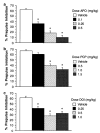
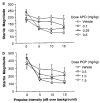
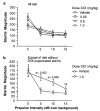
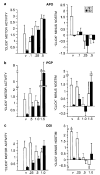
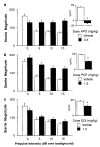

References
-
- Adams CE, Stevens KE. Inhibition of nitric oxide synthase disrupts inhibitory gating of auditory responses in rat hippocampus. J Pharmacol Exp Ther. 1998;287:760–765. - PubMed
-
- Adler LE, Pachtman E, Franks RD, Pecevich M, Waldo MC, Freedman R. Neurophysiological evidence for a defect in neuronal mechanisms involved in sensory gating in schizophrenia. Biol Psychiatry. 1982;17:639–654. - PubMed
-
- Adler LE, Rose G, Freedman R. Neurophysiological studies of sensory gating in rats: effects of amphetamine, phencyclidine, and haloperidol. Biol Psychiatry. 1986;21:787–798. - PubMed
-
- Bolino F, DiMichele V, DiCicco L, Manna V, Daneluzzo E, Casacchia M. Sensorimotor gating and habituation evoked by electro-cutaneous stimulation in schizophrenia. Biol Psychiatry. 1994;36:670–679. - PubMed
-
- Boutros NN, Korzyukov O, Jansen B, Feingold A, Bell M. Sensory gating deficits during the mid-latency phase of information processing in medicated schizophrenia patients. Psychiatry Res. 2004;126:203–215. - PubMed
Publication types
MeSH terms
Substances
Grants and funding
LinkOut - more resources
Full Text Sources
Research Materials

